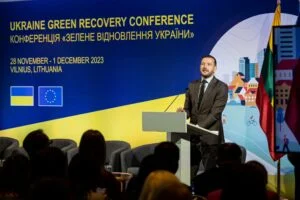Brussels – The goal is on the table as Ukraine approaches two years since Russia invaded it and with a war still at home. “We are launching the Pact for the Environment, our strategy for restoring” the “environmental scars” of the conflict, European Commissioner for the Environment, Virginijus Sinkevičius, announced today (Feb. 9) upon his arrival in Kyiv for a two-day visit to have a political confrontation on Ukraine’s green reconstruction. In particular with President Volodymyr Zelensky, with whom he is scheduled to review the technical work of the high-level working group.
“Europe is an unwavering ally in your fight for freedom,” the head for the environment of the von der Leyen cabinet said, laying the groundwork for discussions on the new plan that is being finalized. As the EU executive explained, the Covenant establishes policy recommendations on three pillars: environmental damage assessment of the war, ecological recovery and reconstruction of Ukraine, and legal accountability for environmental war crimes. Discussions within the High-Level Working Group on the Environmental Consequences of the War began in June 2023, and included among the highlights of the Conference on Ukraine’s Green Recovery organized by the EU Commission in late November last year. Commissioner Sinkevičius’ trip will focus both on the status of Ukraine’s reconstruction and ecological recovery and on Kyiv’s work on environmental priorities of the EU accession process.
The need for close discussions on resources and actions on the ground on this front not only assumes that Ukraine will be a future EU member but also considers the contingent situation of the conflict. According to the data provided by the European Commission, the damage to the environment and environmental infrastructure of the Russian war so far totals more than 52 billion euros. 497 water management facilities were damaged or destroyed, over 1.4 billion euros of damage in the forestry sector, and 20 percent of protected areas were threatened. Today, Ukraine “is the most mined country in the world, not to mention the environmental devastation caused by the destruction of Kakhovka hydroelectric power plant “is the worst man-made disaster since the Chernobyl accident.”
EU tools for green Ukraine
.

The EU is analyzing the available tools to push its support to Kyiv, aiming to support Ukraine’s Green Recovery. First and foremost is the Phoenix Initiative, a combination of several programs first put on the table in early February last year when 15 European commissioners (led by President Ursula von der Leyen) visited Kyiv for a series of meetings with Ukrainian government counterparts. Phoenix has two strands: a €5 million call for proposals in the context of the New European Bauhaus and €7 million in funding from the Horizon Europe and Life programs, focusing on waste management, debris reuse in the building and construction sector, and nature conservation.
In this regard, the New European Bauhaus – the initiative to combine the Green Deal with the reality of living spaces – in Ukraine aims at sustainable, affordable, and needs-based reconstruction: the Bauhaus network is already active in supporting Ukrainian cities and regions on specific issues, such as recyclable materials from demolished buildings and the use of circular construction methods. Regarding the second element of the initiative – Life and Horizon Europe funding for climate-neutral and smart cities – the two calls for proposals dedicated specifically to Ukraine are designed to encourage standards of sustainability and circularity in reconstruction and urban planning development efforts given the common future between Kyiv and the 27 Member States.
English version by the Translation Service of Withub




